Bitfarms Ltd. (NASDAQ: BITF) rides the wave of explosive growth surging by over 110% from its lows of $1.03 per share in November. This BTC miner has witnessed a 41% increase since last Friday, December 1st, 2023. If you’ve been keeping up with our recent articles, you’ll notice that majority of coverage lacks substantial press releases or filings supporting a surge in valuation. Today’s coverage includes precisely that and more. Let’s delve deeper into BITF to assess if this crypto miner is worth considering amidst the ongoing rise in spot BTC.
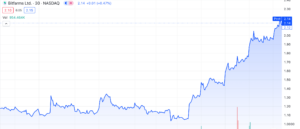 Background:
Background:
Established in 2017, BITF has established itself as a global leader in Bitcoin (BTC) mining. Utilizing its computational power, the company contributes to various mining pools, earning payment in Bitcoin.
BITF sets itself apart by developing, owning, and operating vertically integrated mining farms. These facilities feature in-house management, company-owned electrical engineering services, installation support, and multiple on-site technical repair centers, ensuring a comprehensive operational setup. Bitfarms relies on its proprietary data analytics system, ensuring superior operational performance and uninterrupted service.
Currently managing 11 farms across four countries—Canada, the United States, Paraguay, and Argentina—Bitfarms predominantly uses environmentally friendly hydro-electric power and maintains long-term power contracts. The company remains dedicated to employing sustainable energy sources, often utilizing locally available and under-utilized energy infrastructure.
In its recent upgrade initiative, BITF has improved its fleet’s efficiency and capital practices ahead of the Halving. This strategic move aims to boost its capital-efficient fleet to 12.0 EH/s by Q2 2024. The focus lies in reducing miner and energy costs, enhancing fleet energy efficiency, and fostering greater pricing flexibility for sustained growth and success.
Subscribe to Microcapdaily.com Right Now by entering your Email in the box below.
Market Update:
At the core of BITF’s latest momentum and strength lies its connection to macro-scale factors. To provide deeper insights into BITF’s future prospects, we’ve conducted a comprehensive market analysis.
The latest market surge propelled spot BTC above the USD $44,000 mark at its peak, reaching its highest value in more than 19 months. This remarkable rally emphasizes the enduring positivity shared among retail and institutional traders alike.
Blackrock ETF:
The primary driving force behind Bitcoin’s ascent appears to be rooted in market expectations of an approved spot BTC exchange-traded fund (ETF) in January 2024. This anticipation has spurred substantial cash inflows from institutional investors, contributing significantly to Bitcoin’s current trajectory.
If the approval unfolds as anticipated, it has the potential to bring a substantial wave of fresh capital into Bitcoin. According to certain projections, this approval might introduce up to $50 billion in new liquidity to Bitcoin. The precise impact on Bitcoin’s price remains uncertain; however, a particular model suggests a 4% price surge for every $1 billion that enters Bitcoin. Consequently, if the projected $50 billion materializes, Bitcoin could potentially double or even triple in value.
Rumours from Qatar:
As per bitcoin enthusiast Max Keiser, Qatar’s sovereign wealth fund (QSWF) (mainly tasked with managing the nation’s extensive oil and gas-derived wealth), is contemplating a significant investment spree of up to $500 billion in the flagship cryptocurrency, Bitcoin.
To offer a comparison, this proposed investment dwarfs the disclosed Bitcoin holdings of MicroStrategy, founded by Michael Saylor, by an astonishing 671 times. Presently, MicroStrategy stands as the largest corporate holder of Bitcoin, possessing 174,530 BTC following its acquisition in November.
Keiser is notably optimistic that QSWF’s monumental investment could propel the price of bitcoin to reach soaring highs of $100,000.
Binance Update:
In the aftermath of former Binance CEO Changpeng Zhao’s guilty plea and the subsequent $4.3 billion settlement with the U.S. Department of Justice (DOJ) on Nov. 21, Bitcoin’s price initially showed mixed signals. Contrary to expectations, Binance did not experience a mass exodus of funds similar to what FTX faced during its public liquidity crisis. Notably, prominent figures in the crypto space, such as Galaxy Digital CEO Mike Novogratz, perceive the settlement as a positive development overall.
At first, Binance’s Bitcoin reserves dropped by 17% from their peak. Following the initial outflows, the balance has shown an increase of nearly 1%. As for FTX, their BTC reserves fell a staggering 99.9% from all-time highs in November 2022 ,with no recovery in sight.
This serves as a significant testament to Bitcoin’s resilience at present, even as the largest cryptocurrency exchange by volume faces a monumental lawsuit. Unlike the substantial impact experienced by FTX, this legal challenge did not severely affect BTC reserves.
So What?:
With multiple factors driving spot BTC, smaller-scale BTC miners are becoming increasingly attractive -especially considering the potential financial growth and rising profit margins. Let’s delve into the recent developments concerning BITF for a closer look.
Subscribe to Microcapdaily.com Right Now by entering your Email in the box below.
What Happened:
On December 1st, 2023, BITF released a comprehensive performance and financial update, revealing robust figures for their BTC mining operations. Based on this report alone, it’s evident that BITF boasts a substantial global operational capacity and possesses the financial support needed to remain competitive, particularly as BTC mining grows more challenging post-halving. To enhance clarity, we’ve restructured the release into bullet points for easier comprehension.
BTC Production: November production recorded 392 BTC, a 1.5% decline from October. The network difficulty surged by 19.0% in November, indicating strong miner demand leading into the 2024 Halving.
Network Metrics: For the eleven months ended November 30th, network difficulty increased by 92.2%, while BTC’s price rose approximately 128.4%. This resulted in a 33.9% improvement in production economics measured by USD/TH/day.
Operating Highlights:
- 6.4 EH/s was online by November 30, 2023, marking a 45% increase from November 30, 2022.
- 66.4 BTC/average EH/s was recorded, down 1.9% from October 2023.
- 13.1 BTC earned daily on average in November, equivalent to about $495,200 per day based on a BTC price of $37,800 on November 30, 2023.
Expansion Initiatives:
- Firm purchase order placed for 35,888 Bitmain T21 miners, with an option for an additional 28,000 T21 miners.
- Finalizing contracts to expand operating capacity from 30 MW to 50 MW at Paso Pe, adding 20 MW of hydro-miner containers.
Financial Update:
- Raised $44 million in gross proceeds through a private placement of common stock and warrants.
- Sold 350 BTC, generating $12.8 million in total proceeds.
- Added 42 BTC to treasury, holding a total of 802 BTC, valued at approximately $30.3 million based on a BTC price of $37,800 at November 30, 2023.
- Held Synthetic HODL™ of 35 long-dated BTC call options as of November 30, 2023.
- Reduced outstanding indebtedness by $1.9 million, leaving a remaining balance of $6.0 million at November 30, 2023.
Technical Analysis:
We’re noticing a trend among retail traders on social platforms like X, discussing technical trading patterns related to crypto miners, specifically highlighting positive momentum linked to an Inverse Head and Shoulders (IHS) pattern. A user, @FreeDoomCapital, suggests that among all miners, BITF seems to exhibit the clearest pattern. Here’s a brief explanation of the pattern to enhance your comprehension.
The Inverse Head and Shoulders (IHS) pattern is a technical analysis formation commonly observed in financial markets, particularly in stocks, currencies, and cryptocurrencies. It’s considered a bullish reversal pattern and typically appears after a downtrend.
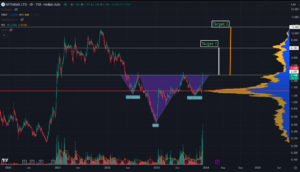
Here’s a further breakdown on the pattern:
- Formation: The pattern consists of three successive troughs. The middle trough (the “head”) is the lowest point, while the two surrounding troughs (the “shoulders”) are higher than the head and relatively symmetrical in height.
- Shoulders: The left and right shoulders are formed at the end of a downtrend. They show a decline in price followed by a temporary stabilization or slight increase before declining again.
- Head: The head is formed after the left shoulder, indicating a further decrease in price, often reaching a new low. However, the head is typically higher than the previous trough, indicating a potential shift in the downward momentum.
- Neckline: The neckline is a trendline connecting the highs of the two shoulders. It acts as a critical level; a breakout above this line is a significant signal for a potential trend reversal.
- Volume: Volume analysis can complement the pattern. Generally, during the formation of the left shoulder, the volume decreases, increases during the head formation, and decreases again during the right shoulder formation. A breakout with higher volume after the formation is considered a stronger confirmation of the pattern.
- Confirmation: A confirmed Inverse Head and Shoulders pattern occurs when the price breaks above the neckline. Traders often look for a sustained move above the neckline to confirm the reversal.
The Inverse Head and Shoulders pattern is considered complete when the price breaks above the neckline, indicating a shift from a downtrend to a potential uptrend. Traders and analysts use this pattern as a signal to anticipate higher prices, and they often set price targets based on the distance between the neckline and the head.
Similar to all technical trading patterns, it’s important to recognize that it’s not foolproof and may not be accurate in every instance. However, it’s noteworthy that several sources are paying attention, particularly due to the apparent clarity of BITF’s formation of an IHS pattern in their lineup.
Conclusion:
An essential consideration with BTC miners is the increasing difficulty of mining the digital asset after halving, which is scheduled for around April 2024. BITF’s recent fleet upgrade aims to strengthen its capacity pre-halving, positioning itself as a frontrunner. With spot BTC around USD $44,000, the 392 BTC mined in November alone would translate to approximately USD $17 million in top line revenue. If potential BTC catalysts sky rocket the price to USD $150,000 as some suggest, November’s mining performance would represent nearly $60 million – and that’s just in one month. As one of the leading BTC miners globally, we highly recommend keeping BITF on your radar.
We will update you on BITF when more details emerge, subscribe to Microcapdaily to follow along!
Disclosure: We have not been compensated for this article/video. MicroCap Daily is not an investment advisor; this article/video does not provide investment advice. Always do your research, make your own investment decisions, or consult with your nearest financial advisor. This article/video is not a solicitation or recommendation to buy, sell, or hold securities. This article/video is our opinion, is meant for informational and educational purposes only, and does not provide investment advice. Past performance is not indicative of future performance.
Picture by WorldSpectrum from Pixabay

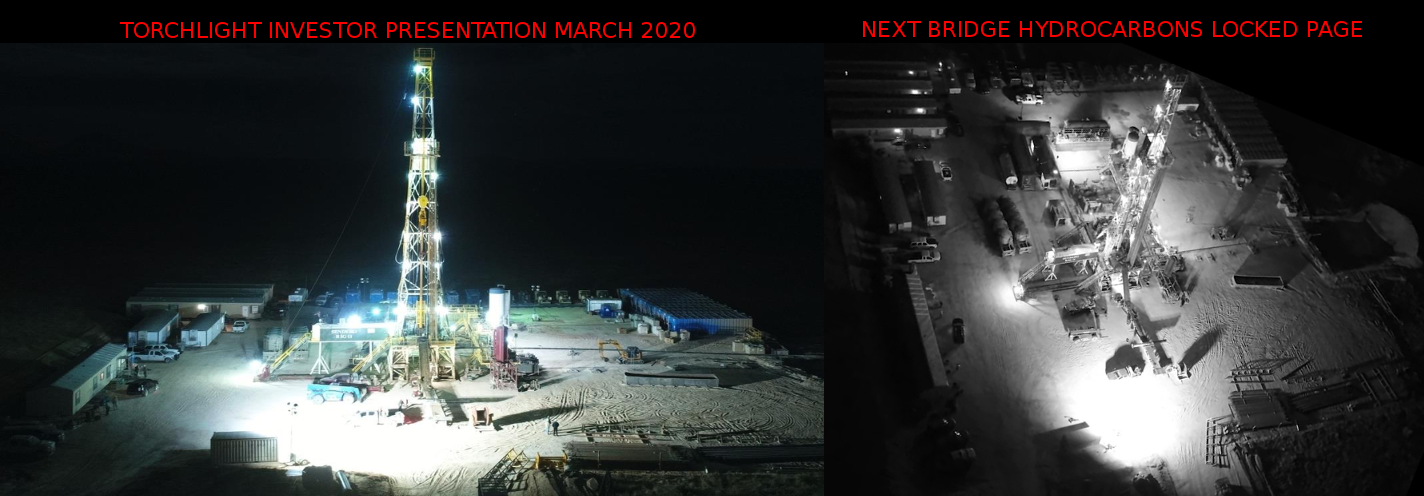
 Uncategorized3 years ago
Uncategorized3 years ago
 Micro Cap Insider4 years ago
Micro Cap Insider4 years ago
 Media & Technology5 years ago
Media & Technology5 years ago
 Featured2 years ago
Featured2 years ago
 Media & Technology4 years ago
Media & Technology4 years ago
 BioPharma4 years ago
BioPharma4 years ago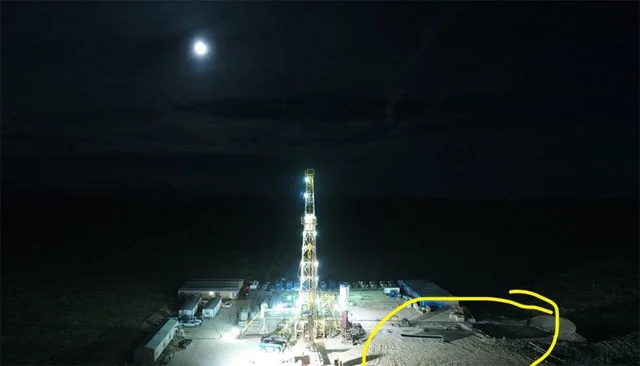
 Uncategorized3 years ago
Uncategorized3 years ago







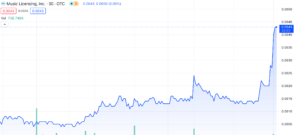

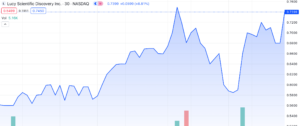

Robert Maguire
December 4, 2014 at 12:57 pm
New article on ECRY https://microcapdaily.wpengine.com/riding-the-statler-express-ecrypt-technologies-inc-otcbbecry/17490/